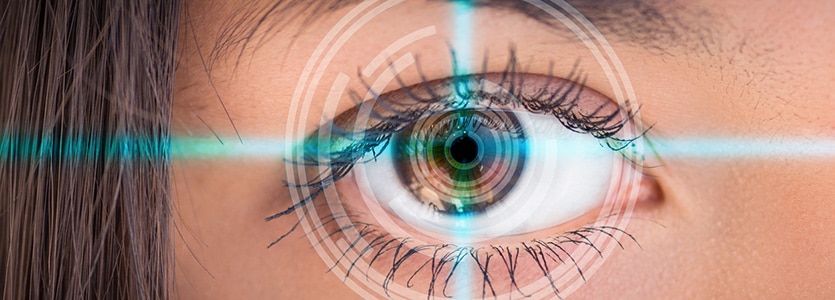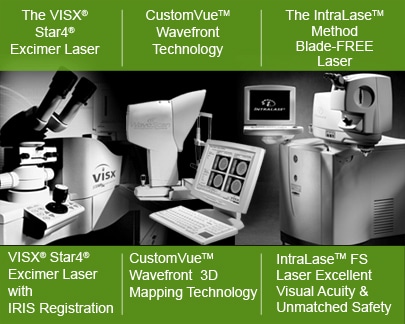
A World Of Better Vision With LASIK
Hattiesburg Eye Clinic surgeons were the first in South Mississippi to introduce LASIK corrective vision surgery and first to offer blade-free iLASIK. iLASIK offers the highest levels of precision and accuracy to safely correct nearsightedness, farsightedness and astigmatism.
We’ve invested in the most advanced technology to provide you the best possible care. Our surgeons have successfully performed thousands of vision correction procedures and are ready to help you choose the option that’s best for your individual vision problem.
Laser vision correction gives patients a chance to reduce or eliminate dependence on glasses and contact lenses.
What Is LASIK?
LASIK is an acronym that stands for laser in-situ keratomileusis. It’s a surgical procedure using laser technology to lift a thin layer of cornea in such a way as to create a flap that stays connected on one side. These flaps are usually only a hundred microns thick, which is quite thin.
After the laser does its job on the flap, we then move the patient to another laser that sculpts the cornea with a cool, ultraviolet light into the right shape to correct the patient’s refractive problem, be it nearsightedness, farsightedness or astigmatism. We then lay the flap down to its original position where it takes about a minute for the cornea to dry to allow the flap to remain adhered. The actual laser time for all the steps in this procedure for most patients is about a minute.
Ideal Candidates For LASIK
You will need to undergo an initial consultation and comprehensive examination. To begin with we perform a test called corneal topography to map the outer surface of the cornea. We will then check your specific vision prescription used in your glasses or contacts to determine if you are nearsighted, farsighted and/or have an astigmatism, and if your prescription is within the range of correction with LASIK.
We will also perform our own refraction tests to determine your true prescription to see normally (20/20) and if you have any limitations in this respect. We follow this with dilation so that we can inspect all the inner structures of the eye such as the retina and optic nerve to assure they’re healthy. We’ll then perform a second refraction while the eyes are dilated to double-check the stability of the prescription we previously obtained. Finally, we check the thickness of the cornea in each eye. This is an extremely important step, because if the cornea is too thin we will be limited on what we can accomplish with LASIK and may need to consider other surgical procedures.
The entire examination takes about thirty minutes to an hour to complete. If our tests indicate that you fall within the parameters to safely perform LASIK, we can then set up a surgical schedule.
The vast majority of iLASIK patients will see 20/20 OR BETTER after surgery … That could be life changing!*
iLASIK For Vision Correction: Safe & Proven
Today, thousands of vision professionals around the world perform over 700,000 procedures every year. In fact, all branches of the U.S. military and NASA approved LASIK for their servicemen and women, thanks to studies using iLASIK technology.
You Can Afford iLASIK!
The iLASIK procedure is more affordable than you think. Hattiesburg Eye Clinic works with CareCredit to help you finance the procedure with monthly payments to fit your budget.

The cost of vision correction varies, based on surgeons’ experience and surgical center fees. We’re not the least expensive provider in our service area because we’ll never sacrifice your safety for the sake of lower fees. We’ve invested heavily in advanced laser technology and our diagnostic technology is second to none. This investment is highly linked to surgical results and our patients tell us they can see the difference.
Getting The Highest Vision Care Needed At The Best Price
While you want the best price possible, quality and service matter when it comes to medical care. After all, laser vision correction is a procedure you’ll have only once in your lifetime and your vision is one of your most important assets. The best way to find out exactly what your price will be is to schedule an exam. After a comprehensive evaluation to determine what procedures you’re a candidate for and what degree of correction you need, we’ll be able to give you a specific price.
Many people have medical flex plans they use to save up to 50 percent on their procedure by using pre-tax dollars. Your employer’s human resources department can tell you whether you have this benefit. Vision correction may be tax deductible as a medical expense (check with your financial advisor).
We do offer affordable payment plans. It is easy to apply online and receive credit approval before you schedule an appointment. We also accept cash, personal checks, Visa and MasterCard.
To learn more about laser vision correction or other vision-related topics visit our Contact Us page or call us at 1-800-624-8254. You can also use either method to request an appointment with an HEC professional at one of our convenient Mississippi locations in Hattiesburg, Columbia or Laurel.
Popularity Of Laser Vision Correction Drives Innovation
With the second and third generation Excimer lasers, very low to moderately high degrees of nearsightedness, farsightedness and astigmatism can be effectively treated. And for many patients that had large pupils, thin corneas or other contraindications for laser vision correction, newer surgical techniques now allow them to enjoy the benefits of clear vision without dependence on glasses and contact lenses.
The iLASIK procedure only takes minutes. It reshapes your cornea to correct the refractive imperfections in your eye (these imperfections are essentially the reason you are nearsighted, farsighted.
The Technology Behind iLASIK:
To correct your vision with the iLASIK procedure, a thin corneal flap needs to be created. There are two ways to make this flap: a blade or the IntraLase™ FS laser. The iLASIK procedure EXCLUSIVELY uses the IntraLase laser; it’s part of what makes iLASIK vision correction unique. Eighty-one percent of patients choose bladeless LASIK over traditional LASIK with a blade when given the choice.

Outcomes may vary. 98% of nearsighted patients participating in the Advanced CustomVue™ FDA Clinical Trials could see 20/20 or better one year after treatment.
Laser Vision Correction Provider Checklist
The decision to have laser or surgical vision correction is an important one that you should make carefully, not quickly. Choose a practice that focuses on safety, diagnostic technology, post-operative follow-up. Obviously, the experience of the surgeon is extremely important as well. We hope you will choose Hattiesburg Eye Clinic as your provider, but if you’re considering your options, use this checklist to compare.
Frequently Asked Questions
The difference between nearsightedness (myopia) and farsightedness (hyperopia) depends on how light rays enter the eye. Light is mostly refracted (changes direction) at the corneal surface at the very front part of the eye. If the shape of the cornea refracts to focus the light rays to the front of the retina, a person can experience nearsightedness where they can see normally up close but their distance vision is blurry. Farsightedness occurs when the shape of the cornea refracts light to focus past the retina. In this case, patients can’t see clearly at either near or far distances.
To correct these two problems we must essentially change the refraction of the light rays so that they focus at the correct location in reference to the retina. Traditionally, we can do this with glasses or contacts, and now we can do the same with refractive surgery like LASIK.
With glasses or contacts we’re using the prescription (the measurement numbers) of the lenses to cause the light to go further back to the retina for nearsightedness, or only as far as the retina for farsightedness. With LASIK we’re reshaping the cornea to do the same thing as corrective lenses. The laser “sculpts” the cornea to make it steeper or flatter to refocus the light rays depending on whether the patient is nearsighted or farsighted.
Astigmatism refers to an abnormal shape of the cornea that must be corrected with glasses, contacts, LASIK surgery or potentially cataract surgery. Instead of a spherical shape, the cornea is misshapen somewhat like a football. This causes light rays entering the cornea from one direction to bend (refract) differently from light rays coming in from another direction as they pass through to the retina. The brain experiences a different effect of light at, for example, 90 degrees than with light entering the cornea at 180 degrees. We use corrective lenses (glasses or contacts) or surgery to alter the shape of the cornea to refocus light rays properly onto the retina for clearer sight.
Every patient’s eye condition is unique. Typically, though, the LASIK procedure at Hattiesburg Eye Clinic costs about $2,000 per eye.
Returning to regular life after LASIK surgery depends on your job or activities. Some patients involved in light sports like tennis or golf may be able to return to their game the day after the procedure. What we’re most concerned with following a LASIK procedure, though, is any risk of trauma to the eye. With that in mind, you’ll want to avoid any activities or situations that might increase that risk. You’ll also want to avoid swimming underwater for six weeks to avoid infection.
Depending on the nature of their work, most patients can return to their job the next day. You’re also cleared to read or use your eyes as you normally would. The only other care you will need is daily medicated eye drops for about two weeks after surgery. Even with these precautions you can expect your eyes to heal quickly.
With any surgery there is always the possibility of side effects. There is a slight risk with LASIK to contract an infection or experience inflammation afterward. We also may not be able to achieve the full prescription based on the measurements we first obtained. These potential complications, however, are quite rare, occurring in less than 1% of patients undergoing LASIK.
During a LASIK procedure, we minimize the chances of any pain or discomfort with the proper use of light sedatives to help relieve any nervousness and local anesthesia (which we use because the patient must remain awake to follow instructions during the procedure).
If anything, most patients will only feel some pressure. But all in all, there is very little chance for any complications and patients generally have a good and pleasant experience.
Unfortunately, most insurance policies won’t cover it. This is because LASIK and similar refractive surgeries are considered cosmetic procedures and not essential for correcting vision (which can be achieved by other means). You will, therefore, need to make other arrangements for payment.
We estimate that with greater than 99% of our LASIK patients we achieve the intended prescription. If you should be among the less than 1% who don’t achieve the full anticipated prescription, you may be able to undergo a second procedure to enhance it at a later date, provided your cornea has enough thickness.
Get In Touch With Us:
To learn more about Hattiesburg Eye Clinic and our services please call us at 601 268 5910 or toll-free at 800 624 8254 or schedule a consultation.
